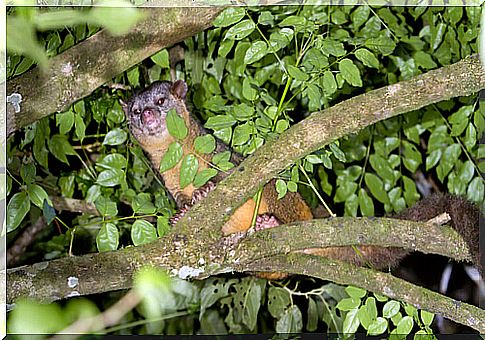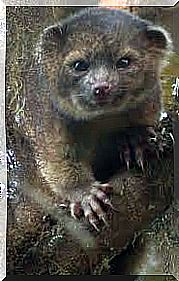Olinguito, A New Species Of Mammal

The olinguito is a species discovered a few years ago by scientists from the Smithsonian Institute in the Andean forests of Ecuador. This specimen has been present in museums and zoos for decades, but had not been properly identified.
Also known as cuataquil, it is a member of the olingo genus of animals and a close relative of raccoons and coatis. Scientists set out to study the various species of olingos extensively and discovered traits that differed markedly from other olingos, including a smaller skull and longer fur.
From there, the team headed to Ecuador in an effort to find out if this newly listed species was still thriving in the wild. And, indeed, they were able to find groups of olinguitos living in the heights of the Andes. Even so, many questions remain about this beautiful specimen.
Morphology, behavior and habitat of the olinguito
The cutest mammal in recent times is a slim animal that can measure between 35 and 50 centimeters in length. Its tail is long hair, slightly ringed, and is an additional 45 centimeters. It has a soft, grayish-brown coat. The snout is pointed and the ears are rounded, and they can weigh an average of 900 grams.
The olinguitos reside in the cloud forests of Ecuador and Colombia, and like to make their homes at altitudes between 1,530 and 2,740 meters. It is not considered as an endangered species. However, it is estimated that its habitat has been deforested by more than 40%, which affects the life expectancy of this specimen.

This animal is arboreal and has great abilities to move by jumping from branch to branch. It has nocturnal habits, is a carnivore, and is thought to be a solitary species. During the duration of the expedition, more than one individual was never observed.
A great find
The discovery of this lineage was announced in August 2013, after expert curators of science museums identified marked differences between the specimens kept there. They used DNA tests to confirm their concerns and were able to determine the new species.
It is the first time in 35 years that a new species of a mammal of the carnivorous order has been discovered in America. The olinguitos have been exhibited to the public for decades without being recognized as a new and different species. The animals had previously been confused with the olingos, a similar lineage of which they are related.
This discovery shows that the world is not fully explored. Its most basic secrets are still unknown and there is much to study and investigate. This is affirmed by scientists and point out that events like this do not happen overnight. The olinguito case took about 10 years, and it was not the original objective of the study carried out at that time.

The initial research consisted of conducting a comprehensive study of tree-dwelling olingos, understanding how many species of olingo should be recognized, and how those species were distributed. Unexpectedly, detailed examination revealed the existence of a species not previously described.
Much remains to be investigated
The information obtained to date has been a joint effort between researchers from the Smithsonian Institute, professionals from Ecuador and contributions made by residents close to the area where the animal lives. However, several expeditions have been planned to closely assess other traits of their behavior.
For this, trips will be made to Colombia and Ecuador. There it is hoped to collect data that will allow for more knowledge about this species. Contact is also maintained with researchers from both countries, who have the task of deepening the study of the mammal.
The effort of these investigations has made it possible to advance in the recognition of the species. The voluntary contributions of the residents consist of videos and photographs of the creature. This has allowed us to learn more about this interesting specimen of nature.
An olinguito baby and its nest high up in the forest canopy have already been observed. With this, the importance of this fact is evidenced and more details of the beautiful animal are expected.









